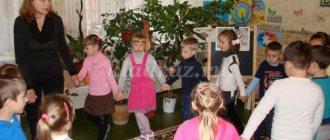Summary of the lesson “Seasons” in the preparatory group
Lesson summary on the topic “Seasons” for older preschoolers
Progress of the lesson
The teacher and children enter the group.
They stand in a circle and perform an exercise aimed at improving their mood. All the children gathered in a circle: I am your friend and you are my friend.
Let's hold hands tightly and smile at each other. Educator: Children, look today we have guests. Let's say hello to them and give our good mood to the guests. The group includes a character (Lesovichok). Lesovichok: Hello children, do you recognize me? Children: Yes, you are Lesovichok. You protect the forest, animals, birds. Lesovichok: Today I came for your help. I live in a fairy forest. There was peace and harmony in nature. Suddenly something changed in him. All seasons have changed places. After winter came summer, after summer came spring, and only after spring came autumn. - But that doesn’t happen! And I can’t do it alone, help me guys put things in order in the fairytale forest. Our path will not be easy; we must remember all the seasons, their signs and characteristics. Educator: Guys, let’s help Lesovich clean up the fairytale forest? Children: Yes, of course we will help. Educator: Then we go to the fairy forest. Lesovichok: - And we will travel on an unusual fairy-tale transport - an airplane carpet. We'll take all our friends on the magic carpet. Let him carry us all across the blue sky Through mountains, seas, oceans. To a fairy forest and magical lands. Lesovichok: Snow on the fields, Ice on the rivers, Blizzard is walking, When does this happen? Children: In winter. (The teacher with the children and Lesovich approach the winter landscape). Educator: what can you say about winter? Children: - The whole earth, houses, trees were covered with snow. — It’s frosty outside, — The birds don’t sing happy songs, — The wind is prickly, cold, blizzard, snowfall. — The rivers are covered with ice. — People are dressed in warm clothes. — The days have become shorter and the nights longer. The sun rarely shines. Educator: Yes, it’s cold outside. Why do we love winter so much? Children: - In winter you can go sledding, skiing, skating. — Build a snowman, play snowballs, build a snow town. — In winter there is New Year, my favorite holiday. — Santa Claus brings gifts. In winter, my dad and I make bird feeders. Lesovichok: Snowflakes want to play with us, they want to know more about themselves, say “Which one is Snowflake?” Children: The snowflake is light, beautiful, spins, and lies on the ground. The snowflake is cold, as soon as you take it in your palms, it melts from the heat and turns into water. And in the cold, the water freezes and becomes ice. Lesovichok: Tell me guys, what happens: A slide made of snow is snowy (children’s answer)
A path made of ice is icy
(children’s answer)
Weather with frost is frosty
(children’s answer)
Weather with wind is windy
(children’s answer)
.
Lesovichok: What a fellow you are, you know everything about winter. Educator: Guys, do you hear the streams ringing, the rooks have arrived. The bee brought the first honey to her hive. Who can say, who knows, When this happens? Children: In the spring. (The teacher with the children and Lesovich approach the spring landscape). Lesovichok: I have a picture, I need to collect it and find out what time of year is depicted here. What time of year is it now? Children: Putting together big puzzles, talking about spring:
- It’s getting warm.
— Buds are blooming on the branches and leaves are appearing. — The grass has appeared. — The first flowers (snowdrops) appear. — Birds fly from warm countries. Lesovichok: Let's talk to you guys about birds. —What do you call the birds that fly south for the winter? Children: Migratory. Lesovichok : What migratory birds do you know? Children: Starlings. - Swallows. - Rooks. - Ducks. - Cranes. Lesovichok: What are the birds that stay with us called? Children: Wintering. Lesovichok: Tell me the wintering birds that you know. Children: Crow, magpie, sparrow, dove, tit, bullfinch, woodpecker. Educator: Well done, guys. Now let's remember what wintering and migratory birds do in the spring? Children: They make nests. The chicks are hatched. Educator: Correct. But people also help birds in the spring. How? Children: People make birdhouses for birds. Educator: So now we will make birdhouses for birds. Please go to your tables. You have geometric shapes in your “sockets”. What are their names? Children: Triangle, square, circle. Educator: Make a birdhouse out of them. Children: They are working. At the end of the work, Lesovichok and the teacher evaluate the work. Children: They tell who they made the house for.
Lesovichok: What else happens in the forest in the spring?
Children: The bear wakes up after hibernation, the Hare changes its white coat to a gray one. Nature comes to life. Educator: Guys, it’s so good in the spring, I don’t even want to leave. Let's play. Stand in a circle. Physical education lesson: If the river is blue - I woke up from sleep. (Hands raised up).
And he runs in the fields, sparkling - So spring has come to us.
(Jumping in place).
If the snow has melted everywhere, And the grass in the forest is visible.
(We squat).
And the birds are singing and circling - It means spring has come to us.
(Clap your hands.) Lesovichok: Our journey continues. At other times of the year, we are now going with you. Listen to the following riddle: I bring warmth. I warm the rivers with myself, I invite you to swim. And you all love me for this, I…. Children: Summer. (The teacher with the children and Lesovich approach the summer landscape). Lesovichok: What’s summer like? Children: It’s hot, - The sun is shining brightly, it’s baking, - The day has become long. — After the rain there is a rainbow. - The wind has become warm, - Berries and fruits are ripening, - The whole earth is covered with green grass, - Birds are chirping cheerfully, chicks are hatching in their nests, - Butterflies and dragonflies are fluttering, - Bees are flying, - We are swimming and sunbathing. Lesovichok: Guys, look, we are in a flower meadow. We are greeted by flowers, what types of flowers are there? Children: Meadow, forest, garden. Meadow (chamomile, poppy, dandelion, cornflower). Forest (lilies of the valley, bells, forget-me-nots). Garden (asters, dahlias, peonies). Lesovichok: Flowers love it when people praise them and say beautiful, pleasant words. Let's tell them these words. D/game “What kind of flowers” Children: Beautiful, colorful, delicate, fragrant, big and small, like the sun. Educator: What are flowers for? Children: In order to give them. To admire them. There are also medicinal flowers (chamomile, calendula, chicory). — Bees collect nectar from flowers, bees make honey from nectar. — Honey is very useful. Lesovichok: It’s time for us to bring order to another time of year. She brings the harvest, Sends the birds to the south, Strips the trees, But does not touch the fir-trees and pines, But her name is... Children : Autumn. (The teacher with the children and Lesovich approach the autumn landscape
).
(Children say the signs of autumn):
The leaves on the trees change their color (become yellow, red, orange, then autumn is called golden. The leaves begin to fall. - People are harvesting, - They are digging potatoes, - The sky is gray, gloomy. - It rains often, - Birds fly south. - Bears and hedgehogs are preparing for hibernation.
Lesovichok: - Now we’ll check if you know the names of trees? Under/game “Collect leaves.” Children: Collect leaves and name them: One, two, three, four, five. We will collect leaves. Birch leaves, Rowan leaves, Oak leaves, Aspen leaves, We will collect, And we will take an autumn bouquet to the group. Educator: Guys, it’s time for us to return to kindergarten. Lesovichok: Thank you, guys, for your help. We helped to restore order in the forest. For this, I want to treat you. (basket with treats). I will be waiting for you to visit me all the time, you are the most welcome guests in my fairy-tale forest. (The teacher and the children go to the magic carpet) . in chorus: We will take all our friends on the airplane carpet. Let it carry us all across the blue sky Through the mountains, seas, oceans, back From the fairy-tale forest to our kindergarten. Educator: Did you like our trip? Children: - Yes! Educator: - Where were we today? Children: - In a fairy forest. Educator: - What time of year was it at first? Children: - Winter. Educator: - What kind of winter is it like? Children: - Snowy, cold. Educator: - When do the birds return home from the south? Children: - In the spring. Educator : - What do people do for birds? Children: - People make birdhouses for birds. Educator: - What time of year is the hottest? Children: - The hottest time is summer. Educator: - Where were we at the end of the walk? Children: - Visiting autumn. Educator: Well, guys, you did a good job. Thank you. Help yourself to fruit and relax.
We recommend watching:
Notes on drawing for the preparatory group of kindergarten. Notes on an art lesson on the topic Autumn. Preparatory group Summary of a speech therapy lesson for the preparatory group on the topic “Seasons” Mnemonics for children of the middle and senior groups “Seasons and their phenomena”
Similar articles:
Fun trip for the older group. Seasons
Conversation in kindergarten in the preparatory group. Seasons in the forest
Summary of a lesson on the topic “Seasons” in the middle group of kindergarten
Activities about the seasons for children 5-7 years old
Outdoor games about the seasons in kindergarten for older children
Summary of the extracurricular lesson “Seasons” for elementary school children
Lesson summary in additional education: “Seasons” for children 7 - 12 years old
Author: Osinovskaya Natalia Yuryevna, teacher of the Municipal Educational Institution “Syavskaya Correctional School - Boarding School”, Nizhny Novgorod region, g.o.g. Shakhunya, Syava village. Description of work: the lesson is intended for children 7-12 years old. Systematize children's knowledge about the sequence of seasons, clarify ideas about the characteristic features of each season. To form ideas about the regular repeatability of changes in the life of nature from season to season. To revive children's impressions of encounters with vivid natural phenomena at different times of the year. Goal: to systematize children’s knowledge about the seasons. Objectives: 1. Educational: •consolidate knowledge about the seasons, activate children’s vocabulary on the topics: winter, spring, summer, autumn; •distinguish and name the essential signs of the seasons; •group signs and objects according to their correspondence according to the symbol; •continue to teach children the question-and-answer form of conversation, to answer in full sentences of different constructions; •strengthen the skills of forming possessive adjectives; •continue to teach how to work with diagrams; •consolidate knowledge of trees, find the corresponding leaves in the exercise “Recognize and name”; •intensify mental activity at the level of monologue, dialogic speech, abbreviated internal speech to oneself. 2.Developing: •develop systematic thinking in the process of expanding knowledge about the seasons; •develop graphic skills; •develop attention, perception; 3. Educational: •to cultivate observation, curiosity, patience. Be able to identify the main signs of seasonal phenomena. Equipment: Multimedia projector, screen;
didactic games: “Magic bag”, “Create a figure”, “Which tree is the leaf from”, “Who lives where?” demonstration, story pictures (seasons). Progress of the lesson:
Educator: Hello guys! The topic of our lesson: “Seasons” - Guys, remember we read the fairy tale: “Twelve Months.”
- Who remembers what the months are called? Answers: (January, February, March, April, May, June, July, August, September, October, November, December). Educator: - As soon as one month ends, another begins immediately. And it has never happened before that February would come before January left, and May would overtake April. - The months go one after another and never meet. And all these 12 months were seen by one girl, in winter, in January. She asked them to help collect snowdrops in the basket. — Is it possible to find snowdrops in winter? Answer: (no)
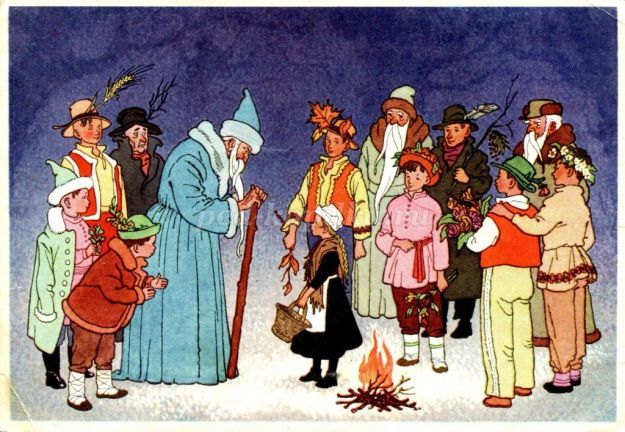
- After the girl told her story: how her stepmother sent her into the winter forest for snowdrops, and told her not to return without them, otherwise it would be bad. “The months whispered and decided to help the girl. They began to give up their places to each other. January gave way to February. February gave way to March. And the month of March gave the girl a basket of snowdrops.
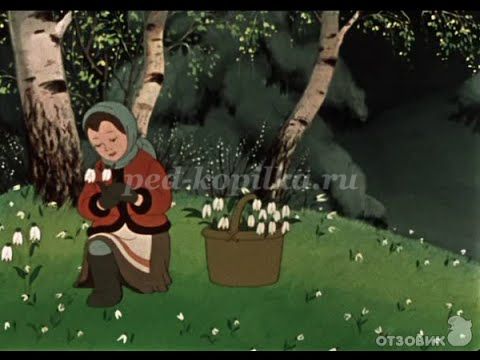
And the girl, thanking for the help, ran home. — When the months began to return to their places, they became confused and their Seasons were mixed up.
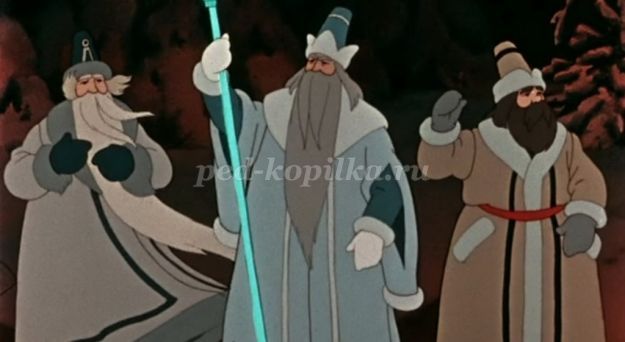
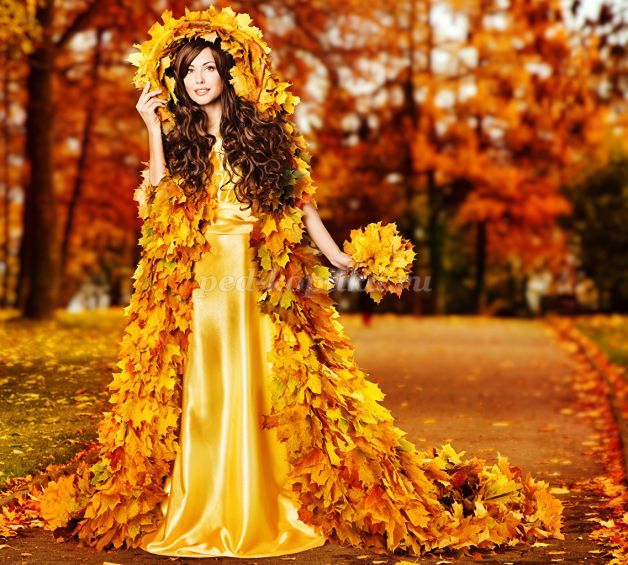
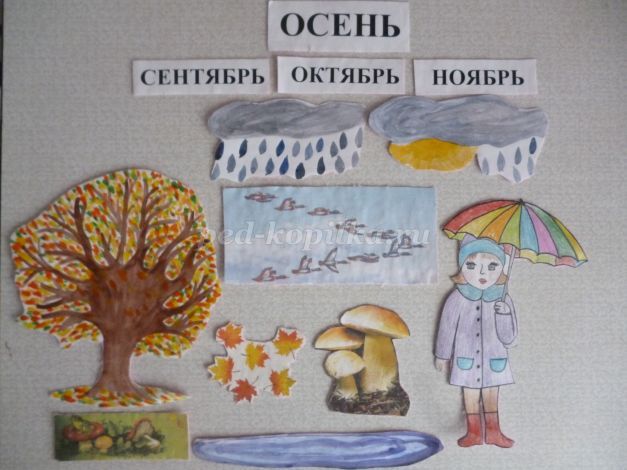
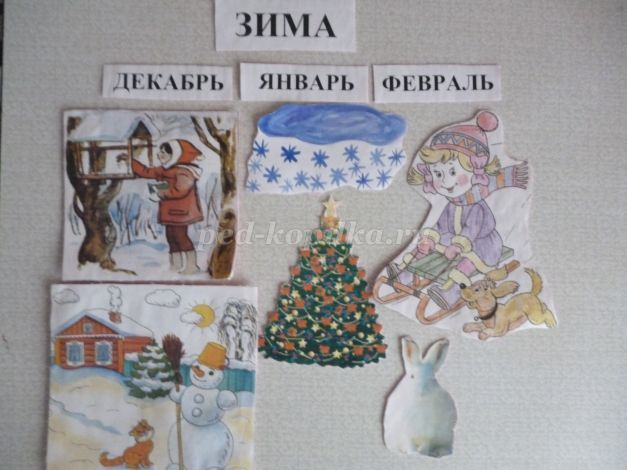
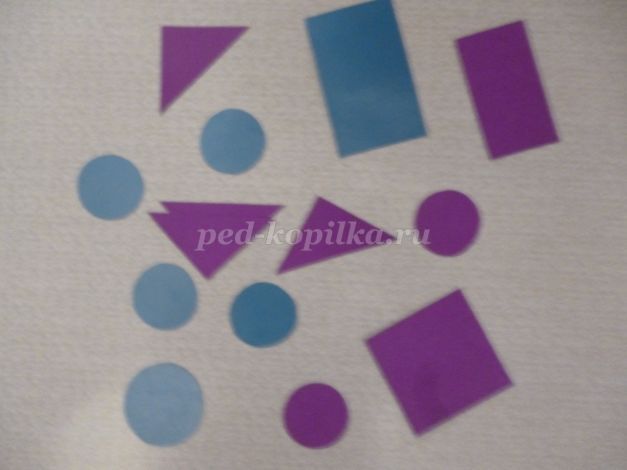
And tell me what you did. Shapes: (snowflake, snowman, house, car, Christmas tree, etc.)

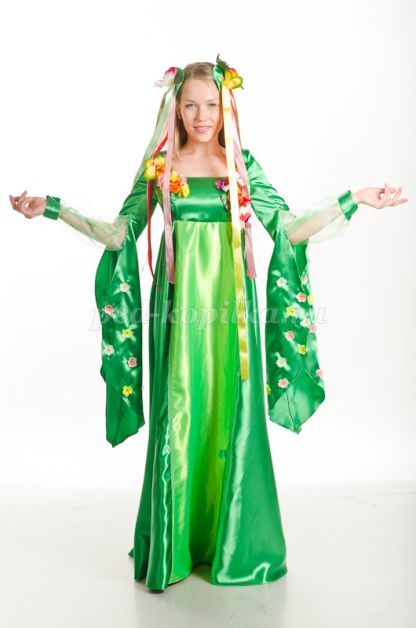
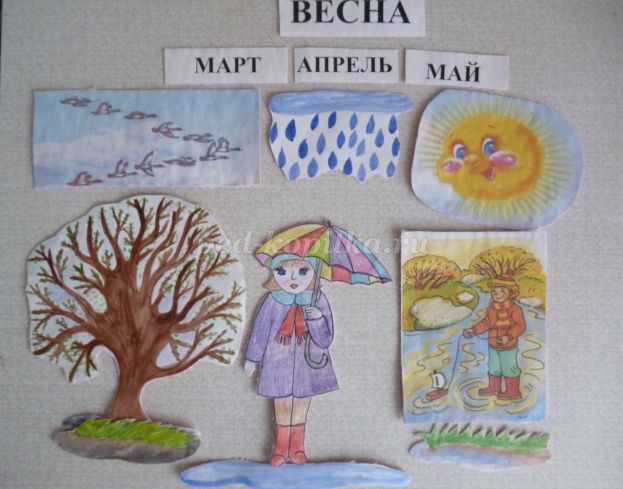
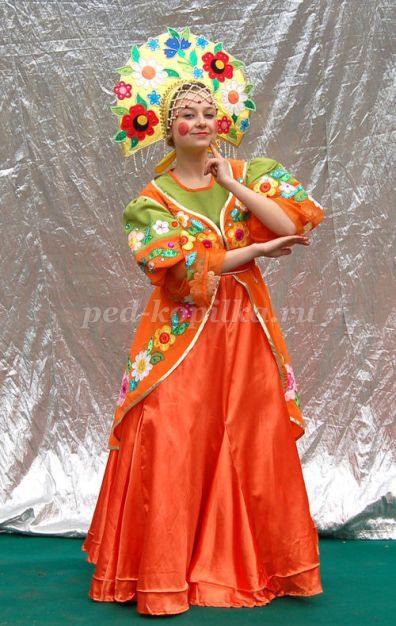
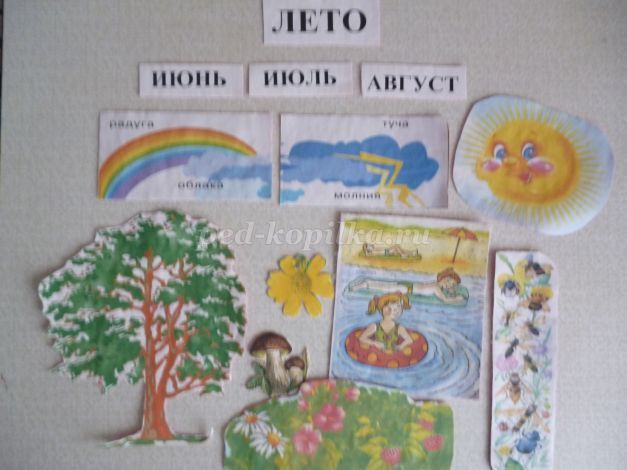
We recommend watching:
Summary of a themed walk in elementary school. Nature has no bad weather Lesson notes for 9th grade students with presentation. Cartoning and bookbinding Summary of a lesson in writing and speech development in the 9th grade of a correctional school with a presentation Summary of a lesson in the 5th grade. Lake Chebarkul
Similar articles:
Tournament of Russian language experts, grades 2-3
Educational activities for children: Seasons
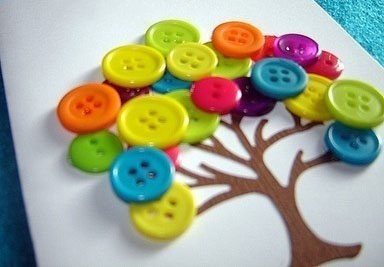
Educational activities together with active educational games introduce preschool children to the seasons of the year in nature. Children will learn about the change of seasons, the colors of nature in different seasons, what the nature calendar is, what clothes to wear correctly in a certain season of the year.
Games and activities on the theme of spring
Game-activities introduce younger preschoolers to the seasonal features of the spring season. In a playful way, children learn to be attentive and learn about what nature looks like in spring. To the page…
Games and activities on the theme of summer
Games-activities form children's ideas about the features of the summer season. In a playful activity, preschoolers learn more about nature in the summer. To the page…
Games and activities on the theme of autumn
Game-activities introduce preschoolers to the characteristics of the autumn season. In the form of play, children develop creative abilities, memory, and general ideas about the features of nature in autumn. To the page…
Games and activities on the theme of winter
Games-activities introduce children of the younger group of kindergarten to the cold and snowy season in winter. Through play, children develop imagination, curiosity and general knowledge about what winter nature looks like. To the page…
Lesson: Nature Calendar
The lesson contains a drawing of a circle-calendar, consisting of four parts, each representing one season. The lesson has four pages, each about a season: spring, summer, autumn and winter.
With the help of poems, pictures, presentations and assignments, it tells about each month of the season, natural phenomena in each month, what holidays and how to dress for the season. To the page…
Lesson: Colors and Seasons
An unusual activity that talks about how each season has its own colors. For example, spring is red, summer is green, autumn is yellow, winter is blue. The task contains four seasons, along with descriptions and pictures there is a presentation about colors and a task-game to color the rainbow. To the page…
Activity: Clothes for the seasons
The game contains 12 pictures depicting a boy and a girl dressed in a certain season of the year. Each picture corresponds to the time of year and month according to certain characteristics. Assignment: first arrange the pictures into seasons, and then into months in each season, focusing on the clue details in the pictures. To the page…
Activity: Quiz “Seasons” for the little ones
An exciting quiz with questions and answers about the seasons. First you need to find out about each season, how the seasons differ and what you can do during these seasons, and then a quiz for the most skillful with questions and pictures. To the page…

